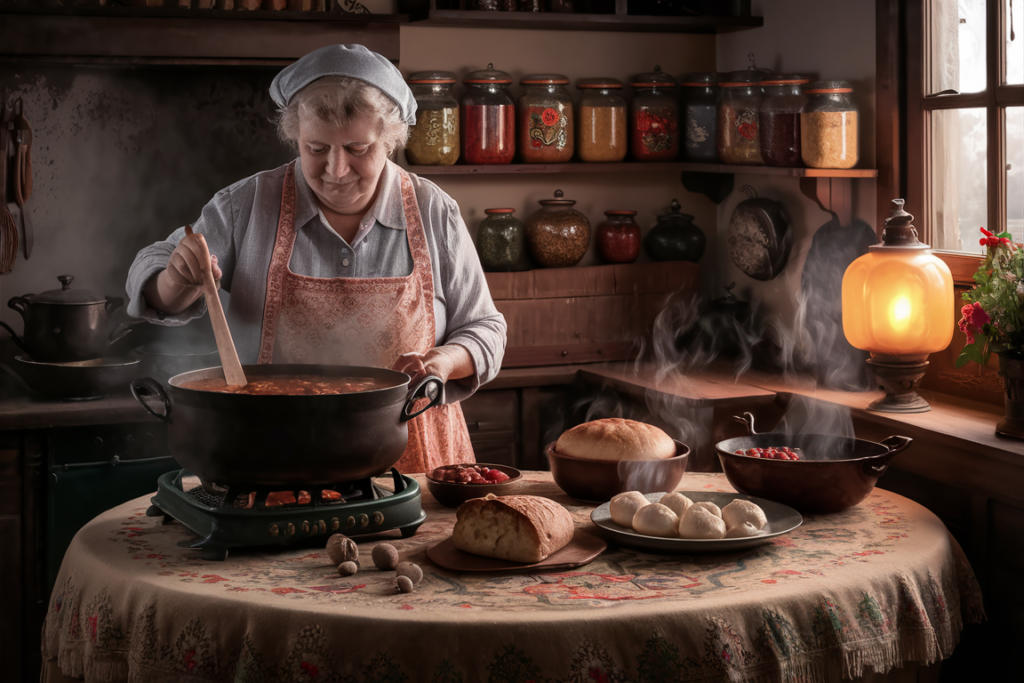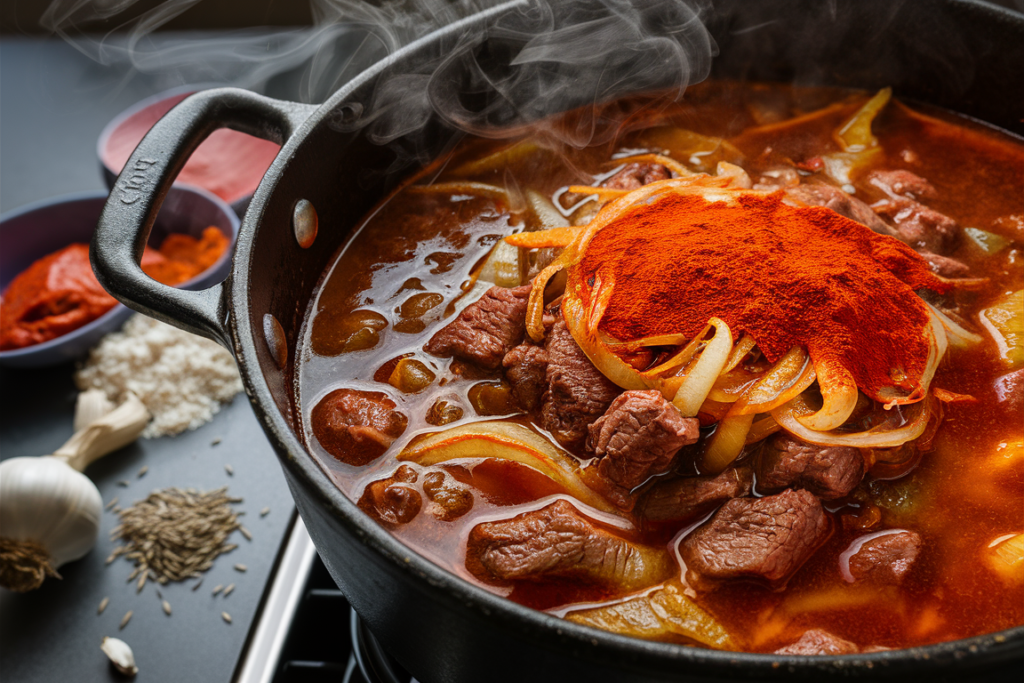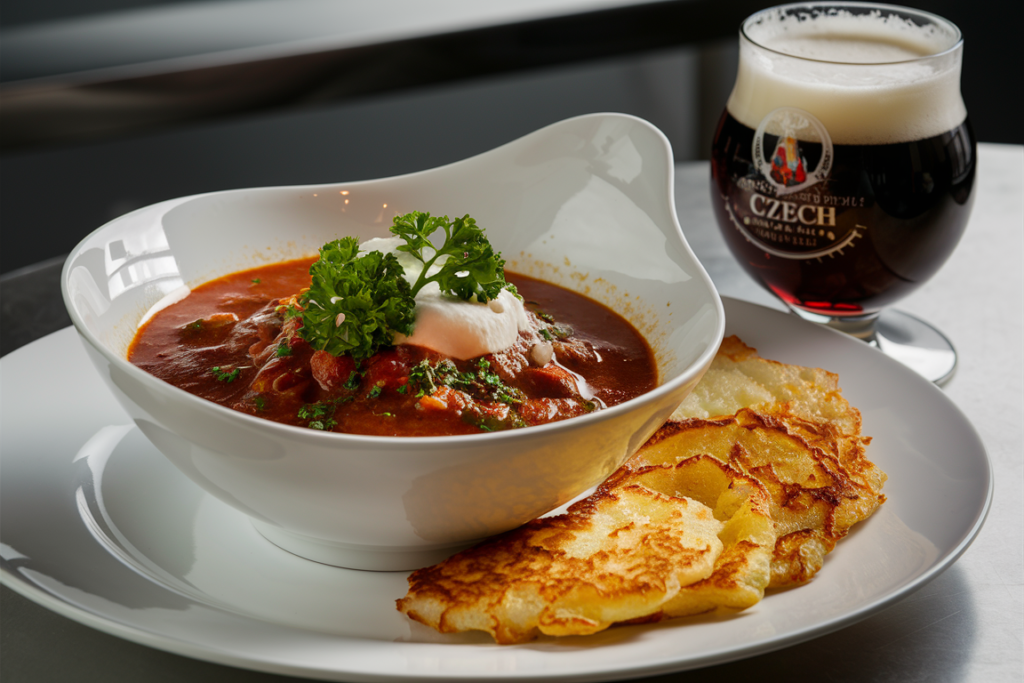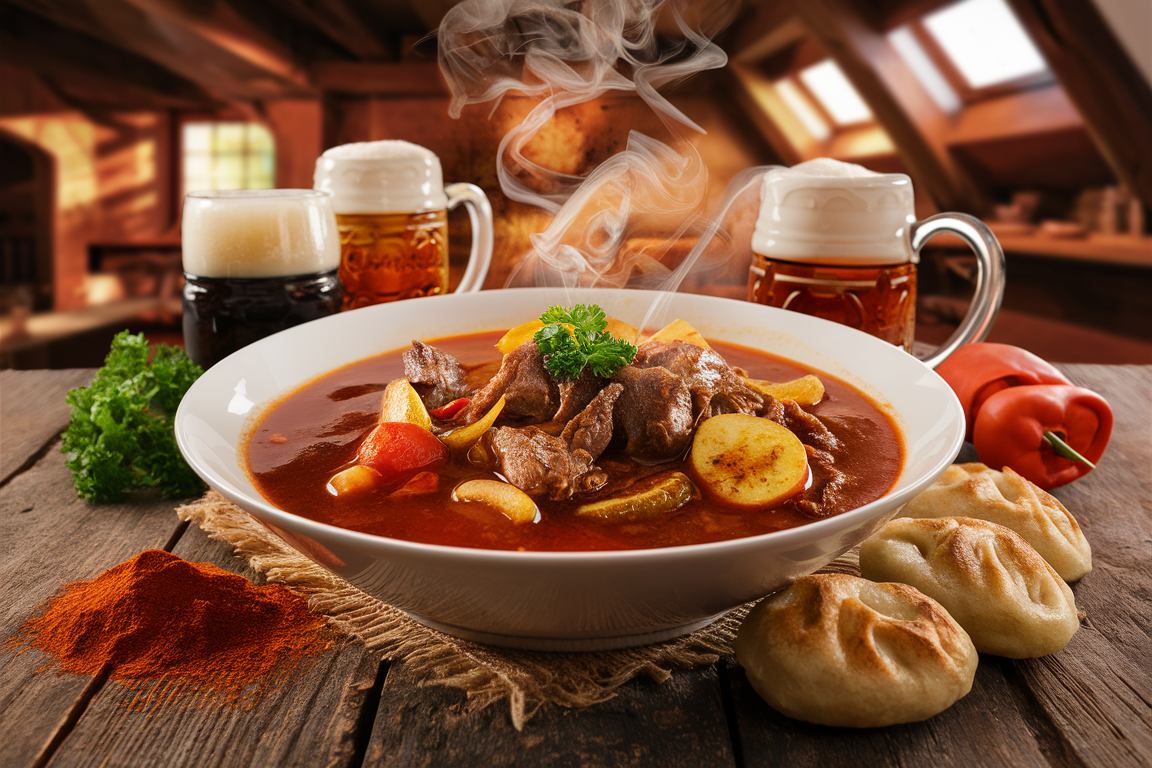Part 1: Introduction to Czech Goulash
Czech goulash, or “guláš,” is one of the most iconic dishes in Czech cuisine. This hearty stew combines tender beef, rich spices, and a silky, paprika-infused sauce that warms both the heart and soul. Known for its deep flavors and comforting appeal, Czech goulash is a staple of Czech households and a must-try for food enthusiasts exploring Central Europe.
Unlike other stews, Czech goulash is celebrated not just as a meal but as a symbol of hospitality and tradition. With its versatility to pair beautifully with bread dumplings or potato pancakes, it has found a place in both rustic kitchens and fine dining restaurants.
The History of Goulash in Czech Cuisine
Goulash originated in Hungary as a robust meal for herdsmen. Its journey into Czech culinary culture began during the Austro-Hungarian Empire, where regional flavors adapted and reshaped the dish. While Hungarian goulash emphasizes a soupy consistency and abundant paprika, Czech goulash leans toward a thicker stew with caramelized onions at its heart.
The Czech version took on a life of its own, incorporating local ingredients like caraway seeds and a variety of paprika types. Over the centuries, it evolved into a dish of cultural pride, served during family gatherings and national festivals.

Difference Between Hungarian and Czech Goulash
Though they share common roots, Hungarian and Czech goulash differ significantly in flavor and texture:
- Consistency: Czech goulash is thicker and heartier, while Hungarian goulash is more like a soup.
- Spices: Hungarians often use hotter paprika, whereas the Czech version balances sweet and smoky varieties.
- Ingredients: Czech goulash often includes caraway seeds and marjoram, ingredients less common in its Hungarian counterpart.
This distinction highlights how the dish mirrors the cultural identities of the two nations.
Cultural Significance of Goulash in the Czech Republic
Czech goulash is more than a dish; it’s a symbol of community and heritage. It’s the centerpiece of family dinners, a staple at Czech beer halls, and a beloved choice at festive events like the annual Prague Goulash Festival.
In Czech culture, food often brings people together, and goulash embodies this sentiment perfectly. It’s common for families to pass down unique goulash recipes, adding a personal twist to an already iconic meal.
Evolution of Goulash Recipes Over Time
The recipe for Czech goulash has evolved significantly over time, adapting to the tastes and needs of each generation. Historically, goulash was a simple, affordable meal made with basic ingredients. Over time, however, cooks began experimenting with different types of paprika, cuts of meat, and even wine to deepen the flavors.
Modern versions sometimes incorporate mushrooms, bell peppers, or even dark beer to give the dish a more contemporary twist while staying true to its traditional roots.
Key Ingredients in Czech Goulash
Czech goulash relies on simple yet flavorful ingredients:
- Beef: Typically chuck or shin, prized for their tenderness when slow-cooked.
- Onions: A crucial base ingredient, caramelized to create depth and sweetness.
- Paprika: Both sweet and smoked paprika are key, giving the dish its signature color and warmth.
- Garlic: Adds a layer of aromatic complexity.
- Tomato Paste: Balances the richness with a hint of acidity.
- Caraway Seeds and Marjoram: Distinctly Czech spices that enhance the flavor.
These ingredients create a harmonious blend that defines the essence of Czech goulash.
Types of Paprika Used in Goulash
Paprika is the soul of goulash, and the type you use can transform the dish entirely:
- Sweet Paprika: Adds depth and sweetness without heat.
- Spicy Paprika: For those who enjoy a bit of a kick.
- Smoked Paprika: Infuses the dish with a smoky, earthy flavor.
Czech goulash typically uses a mix of sweet and smoked paprika to strike a balance between warmth and complexity.
The Role of Goulash in Czech Gastronomy
Goulash occupies a central position in Czech gastronomy, showcasing the country’s love for bold flavors and hearty meals. It’s a menu staple in restaurants ranging from traditional beer halls to modern bistros, reflecting its timeless appeal.
Notably, Czech beer is considered the perfect companion to goulash. The malty flavors of a good Pilsner or a dark lager complement the dish’s robust spices beautifully.
Popular Side Dishes with Goulash
The magic of Czech goulash isn’t complete without its traditional side dishes:
- Bread Dumplings (Knedlíky): Soft, pillowy slices perfect for soaking up the rich sauce.
- Potato Pancakes (Bramboráky): Crispy, savory pancakes that add texture and flavor.
- Boiled Potatoes: A lighter, simpler option.
These accompaniments not only enhance the flavors but also make the dish feel like a complete meal.
Regional Variations of Goulash in Czechia
Regional takes on goulash add another layer of intrigue to this beloved dish. For instance:
- Prague Goulash: Often enriched with dark beer for a bolder flavor.
- Moravian Goulash: Features slightly spicier notes, reflecting Hungarian influences.
- Špekové Knedlíky with Goulash: A Southern Bohemian twist pairing goulash with dumplings stuffed with bacon.
Each region’s adaptation showcases the versatility of goulash while staying true to its roots.
Part 2: A Step-by-Step Culinary Journey
A Step-by-Step Guide to Cooking Czech Goulash
Making authentic Czech goulash is a labor of love that rewards with rich, savory flavors. The process involves slow cooking to allow the spices and meat to meld into a velvety stew. Below is a detailed guide to prepare this iconic dish.

- Ingredients: Gather beef, onions, paprika, garlic, caraway seeds, marjoram, tomato paste, and beef broth.
- Prep Work: Chop onions and cube the beef.
- Cooking: Sauté onions, sear the beef, and simmer everything with spices.
- Final Touches: Adjust seasonings and serve with traditional sides.
By carefully following each step, you’ll create a dish bursting with traditional Czech flavors.
Choosing the Right Cut of Meat
For goulash, the choice of meat is crucial. The best cuts for slow cooking include:
- Beef Chuck: Its marbling breaks down into tender, flavorful bites.
- Beef Shin (Shank): Slightly tougher but adds a gelatinous richness when slow-cooked.
- Alternatives: Pork or venison can be used for a twist on the classic.
Avoid lean cuts like sirloin, as they lack the fat content needed for a succulent stew.
Essential Kitchen Tools for Making Goulash
To make Czech goulash seamlessly, a few key tools can make a difference:
- Heavy-Duty Pot or Dutch Oven: Retains heat and ensures even cooking.
- Sharp Knife: For precise chopping of beef and onions.
- Wooden Spoon: Ideal for stirring and preventing scratches on cookware.
- Ladle: For serving without spills.
Investing in quality tools can elevate your cooking experience and help achieve professional results.
Preparation of Ingredients
Preparation is the foundation of any great dish. Here’s how to prep for goulash:
- Beef: Cut into uniform cubes for even cooking.
- Onions: Dice finely to ensure they caramelize properly.
- Paprika: Measure accurately to balance sweetness and spice.
- Garlic: Mince or crush for maximum flavor release.
Prepping all ingredients before cooking ensures a smooth and stress-free process.
Techniques for Sautéing Onions and Paprika
A critical step in making goulash is sautéing the onions and paprika.
- Onions: Cook on medium heat until golden brown and caramelized. This creates a sweet, flavorful base.
- Paprika: Add to the onions briefly to release its oils and deepen the flavor. Be careful not to burn it, as paprika can become bitter if overcooked.
Mastering this step ensures your goulash has a rich, aromatic foundation.
How to Create the Perfect Goulash Base
The base of goulash is a harmonious blend of spices, broth, and tomato paste.
- Spices: Combine paprika, caraway seeds, and marjoram for a signature Czech flavor.
- Broth: Use beef broth for depth; water can dilute the flavor.
- Tomato Paste: Adds acidity and enhances the sauce’s thickness.
Simmer the ingredients together to create a rich, velvety base that coats the meat beautifully.
Simmering and Timing Tips
The secret to tender meat and a flavorful stew lies in slow cooking.
- Low and Slow: Cook on low heat for 2–3 hours to break down tough fibers.
- Stir Occasionally: Prevent the bottom from burning by stirring every 20–30 minutes.
- Check Consistency: If the sauce becomes too thick, add a splash of water or broth.
Patience is key to achieving that melt-in-your-mouth texture and balanced flavor.
Adjusting Spices to Personal Taste
One of the joys of cooking goulash is tailoring it to your preferences.
- Heat: Add a pinch of cayenne if you like a spicy kick.
- Sweetness: Balance acidity with a teaspoon of sugar or honey.
- Saltiness: Always season gradually to avoid overpowering the dish.
Experimenting with flavors allows you to make the dish uniquely yours while honoring its roots.
Common Mistakes to Avoid in Goulash Preparation
Even experienced cooks can run into issues when making goulash. Avoid these common pitfalls:
- Burning Onions: Cook on medium heat and stir constantly.
- Overcooking Meat: Beef should be tender, not mushy. Test a piece before serving.
- Using Too Much Paprika: While essential, overdoing it can result in bitterness.
Being mindful of these mistakes ensures a smooth cooking process and a delicious result.
Serving Suggestions for Czech Goulash
The presentation of goulash can elevate your dining experience.
- Bread Dumplings: Arrange slices around the plate for a classic look.
- Garnish: Sprinkle with fresh parsley or a dollop of sour cream for color and creaminess.
- Pairing: Serve alongside a chilled Czech beer like Pilsner Urquell for an authentic touch.
A well-plated goulash not only satisfies the palate but also delights the eyes.
Part 3: Exploring Beyond the Basics
Variations of Goulash in Central Europe

Goulash is a beloved dish across Central Europe, but each country adds its unique flair:
- Slovak Goulash: Often lighter and served with soft bread or boiled potatoes.
- Austrian Goulash: Features a spicier, thinner sauce with less emphasis on paprika.
- Polish Goulash: Incorporates mushrooms and a touch of cream for a richer flavor.
These regional adaptations demonstrate the versatility of goulash and its ability to unite culinary traditions while celebrating local ingredients.
Vegetarian and Vegan Czech Goulash
For plant-based eaters, vegan Czech goulash offers a satisfying alternative.
- Meat Alternatives: Use mushrooms, seitan, or tempeh to mimic the texture of beef.
- Rich Base: Create depth with caramelized onions, smoked paprika, and vegetable broth.
- Thickening Options: Add potatoes or a roux made from flour and plant-based butter.
Vegan goulash retains the comforting essence of the original while being kinder to the environment and inclusive of dietary preferences.
Nutritional Profile of Czech Goulash
Czech goulash is a hearty meal packed with nutrients:
- Protein: The beef provides a significant protein boost.
- Vitamins and Minerals: Paprika is rich in Vitamin C, while onions add antioxidants.
- Calories: A typical serving with dumplings ranges between 400–600 calories, depending on the portion size.
While indulgent, goulash can be balanced by pairing it with lighter sides like steamed vegetables.
Tips for Storing and Reheating Goulash
Goulash often tastes better the next day as the flavors have more time to meld. To store and reheat it properly:
- Storage: Keep in an airtight container in the refrigerator for up to 3 days. For longer storage, freeze in portioned containers.
- Reheating: Warm slowly on the stove, adding a splash of water or broth to restore consistency. Avoid microwaving, as it can dry out the meat.
Proper storage not only ensures safety but also maintains the dish’s quality over time.
Pairing Drinks with Czech Goulash
No meal is complete without the right beverage, and goulash pairs beautifully with traditional Czech drinks:
- Beer: Pilsners like Pilsner Urquell or dark lagers complement the stew’s hearty flavors.
- Wine: A medium-bodied red wine, such as Pinot Noir, balances the richness of the dish.
- Non-Alcoholic: Try herbal teas or sparkling water with a slice of lemon for a lighter option.
Choosing the right drink enhances the meal and elevates the dining experience.
Czech Goulash as Street Food
Though traditionally a home-cooked meal, goulash has made its way into street food culture in the Czech Republic. At food festivals and markets, you’ll often find:
- Goulash Bread Bowls: Served in hollowed-out loaves for a portable and edible experience.
- Mini Goulash Plates: Paired with smaller dumplings for convenience.
- Festive Versions: Spiced up with regional ingredients during events like the Prague Goulash Festival.
This trend makes goulash accessible to both locals and tourists, showcasing its versatility and appeal.
Modern Twists on Traditional Goulash
Contemporary chefs are putting innovative spins on Czech goulash to cater to evolving tastes:
- Beer-Infused Goulash: Using craft beers for a deeper, maltier flavor.
- Seafood Goulash: A lighter, coastal-inspired version featuring fish or shrimp.
- Fusion Goulash: Combining traditional flavors with global elements, such as adding curry spices or coconut milk.
These creative adaptations prove that goulash can evolve without losing its essence.
Goulash in Czech Pop Culture
Goulash holds a special place in Czech movies, literature, and folklore. It often symbolizes warmth, community, and resilience in stories of family gatherings or rural life.
For example, in many Czech films, a steaming bowl of goulash is a sign of comfort and home. It also frequently appears in folk tales as a meal shared by villagers or a reward for hard work.
This cultural presence underscores goulash’s role as more than food—it’s a cultural emblem.
How to Host a Czech Goulash Dinner Party
Hosting a Czech-themed dinner party centered around goulash is a unique way to bring people together. Here’s how to plan it:
- Decor: Use rustic table settings, with Czech-inspired colors like red, white, and blue.
- Menu: Serve goulash with bread dumplings, pickled vegetables, and Czech desserts like kolache.
- Drinks: Stock traditional Czech beers or wines.
- Atmosphere: Play Czech folk music or modern Czech playlists for an authentic vibe.
Such a gathering celebrates Czech cuisine and culture while creating lasting memories.
Czech Goulash Recipe for Beginners
For novice cooks, here’s a simplified version of goulash:
- Ingredients: Beef, onions, paprika, garlic, tomato paste, and broth.
- Steps:
- Sauté onions and garlic.
- Add beef cubes and brown them.
- Stir in paprika, tomato paste, and broth.
- Simmer until the meat is tender.
This beginner-friendly recipe captures the essence of goulash without overwhelming steps, making it accessible for anyone.
More FAQs About Czech Goulash
- What makes Czech goulash unique?
Its thicker consistency, sweet paprika, and use of caraway seeds set it apart. - Can I use pork instead of beef?
Yes, pork is a popular alternative in some regional variations. - What type of paprika is best?
A mix of sweet and smoked paprika provides balance and depth. - How long does it take to cook?
About 2–3 hours, depending on the cut of meat. - Is goulash spicy?
Traditional Czech goulash is mild, but you can adjust the spice level. - What are common mistakes in making goulash?
Burning onions, overcooking the meat, or using low-quality paprika. - Can I freeze goulash?
Absolutely! It freezes well and reheats beautifully. - What sides pair best with goulash?
Bread dumplings, potato pancakes, or boiled potatoes. - Can I make it gluten-free?
Yes, by skipping flour-based thickeners or using gluten-free alternatives. - Why does it taste better the next day?
The flavors have more time to meld, enhancing the overall taste.

